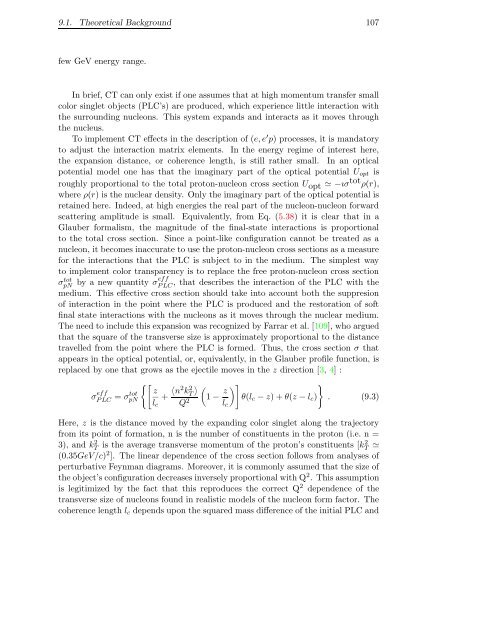Download Thesis in Pdf Format - Theoretical Nuclear Physics and ...
Download Thesis in Pdf Format - Theoretical Nuclear Physics and ...
Download Thesis in Pdf Format - Theoretical Nuclear Physics and ...
You also want an ePaper? Increase the reach of your titles
YUMPU automatically turns print PDFs into web optimized ePapers that Google loves.
9.1. <strong>Theoretical</strong> Background 107<br />
few GeV energy range.<br />
In brief, CT can only exist if one assumes that at high momentum transfer small<br />
color s<strong>in</strong>glet objects (PLC’s) are produced, which experience little <strong>in</strong>teraction with<br />
the surround<strong>in</strong>g nucleons. This system exp<strong>and</strong>s <strong>and</strong> <strong>in</strong>teracts as it moves through<br />
the nucleus.<br />
To implement CT effects <strong>in</strong> the description of (e, e ′ p) processes, it is m<strong>and</strong>atory<br />
to adjust the <strong>in</strong>teraction matrix elements. In the energy regime of <strong>in</strong>terest here,<br />
the expansion distance, or coherence length, is still rather small. In an optical<br />
potential model one has that the imag<strong>in</strong>ary part of the optical potential U opt is<br />
roughly proportional to the total proton-nucleon cross section U opt ≃ −ıσ tot ρ(r),<br />
where ρ(r) is the nuclear density. Only the imag<strong>in</strong>ary part of the optical potential is<br />
reta<strong>in</strong>ed here. Indeed, at high energies the real part of the nucleon-nucleon forward<br />
scatter<strong>in</strong>g amplitude is small. Equivalently, from Eq. (5.38) it is clear that <strong>in</strong> a<br />
Glauber formalism, the magnitude of the f<strong>in</strong>al-state <strong>in</strong>teractions is proportional<br />
to the total cross section. S<strong>in</strong>ce a po<strong>in</strong>t-like configuration cannot be treated as a<br />
nucleon, it becomes <strong>in</strong>accurate to use the proton-nucleon cross sections as a measure<br />
for the <strong>in</strong>teractions that the PLC is subject to <strong>in</strong> the medium. The simplest way<br />
to implement color transparency is to replace the free proton-nucleon cross section<br />
by a new quantity σeff<br />
P LC<br />
, that describes the <strong>in</strong>teraction of the PLC with the<br />
medium. This effective cross section should take <strong>in</strong>to account both the suppresion<br />
of <strong>in</strong>teraction <strong>in</strong> the po<strong>in</strong>t where the PLC is produced <strong>and</strong> the restoration of soft<br />
f<strong>in</strong>al state <strong>in</strong>teractions with the nucleons as it moves through the nuclear medium.<br />
The need to <strong>in</strong>clude this expansion was recognized by Farrar et al. [109], who argued<br />
that the square of the transverse size is approximately proportional to the distance<br />
travelled from the po<strong>in</strong>t where the PLC is formed. Thus, the cross section σ that<br />
appears <strong>in</strong> the optical potential, or, equivalently, <strong>in</strong> the Glauber profile function, is<br />
replaced by one that grows as the ejectile moves <strong>in</strong> the z direction [3, 4] :<br />
σpN tot<br />
{[ 〈<br />
σ eff<br />
z n 2<br />
P LC = k 2 〉 (<br />
σtot<br />
T<br />
pN +<br />
l c Q 2 1 − z ) ] }<br />
θ(l c − z) + θ(z − l c )<br />
l c<br />
. (9.3)<br />
Here, z is the distance moved by the exp<strong>and</strong><strong>in</strong>g color s<strong>in</strong>glet along the trajectory<br />
from its po<strong>in</strong>t of formation, n is the number of constituents <strong>in</strong> the proton (i.e. n =<br />
3), <strong>and</strong> k 2 T is the average transverse momentum of the proton’s constituents [k2 T ≃<br />
(0.35GeV/c) 2 ]. The l<strong>in</strong>ear dependence of the cross section follows from analyses of<br />
perturbative Feynman diagrams. Moreover, it is commonly assumed that the size of<br />
the object’s configuration decreases <strong>in</strong>versely proportional with Q 2 . This assumption<br />
is legitimized by the fact that this reproduces the correct Q 2 dependence of the<br />
transverse size of nucleons found <strong>in</strong> realistic models of the nucleon form factor. The<br />
coherence length l c depends upon the squared mass difference of the <strong>in</strong>itial PLC <strong>and</strong>















